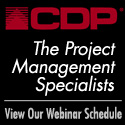
|
www.agc.org Contact Us Archives/Subscribe Advertise IT Forum IT Forum Steering Committee |
7 Tips for a Successful Software ImplementationSince you already know how to build profitable projects, applying basic construction logic to your software implementation lessens the pain so you can move forward with anticipation – instead of dread. Keeping the construction process in mind, here are seven tips for a successful software implementation. 1. Define Success Up Front Why this is important: If you don’t define the meaning of success, how will you know if it has been achieved? The easiest way to define a successful software implementation is to identify existing procedures that aren’t working and outline how you will improve them. Let’s say you want to replace a labor-intense, spreadsheet-based work-in-progress (WIP) reporting system with an automated process within your new accounting software that eliminates duplicate effort and takes seconds to complete. In this case, success is easily measurable. 2. Spend Time Up Front Planning Your Coding Structure Why this is important: A standardized coding structure allows you to gain greater business insight through your software’s reporting system. For example, with a departmentalized GL structure, you can quickly access specific information related to a single department, such as your service department. And, when a master setup for job cost codes is established, account #100 will always signify the 3. Clean Up Your Data Why this is important: This step helps you start with a fresh and timely dataset in your new system. If you have receivables that are outstanding by 120 days or more, ask a) why are these here and b) what can we do now to collect the money? If you have outstanding credits with little-used vendors, instead of carrying those credits forward, consider requesting refunds. Perhaps it’s time to archive data for employees that haven’t worked for the company in years. For current employees, this allows you to identify whether you have current W-4 forms on file and if any critical licenses or certifications have expired. 4. Create a Schedule with Milestones Why this is important: To achieve software implementation success, there needs to be some accountability for the things that must be done. Make the two PMs ultimately responsible for driving the project toward completion – on time and on budget. Let your company’s size and the complexity of your software system dictate the schedule, but try to set a firm go-live date. Like many construction projects, unforeseeable delays happen during software conversions. It’s OK to make adjustments to your schedule. But be aware that if you keep moving your go-live date further into the future, you risk losing momentum and creating costly delays. 5. Implement Your New Software in Phases Phase #1 builds the foundation. Implement basic functionality that replaces and improves upon the procedures you were doing before. The focus during Phase #1 should be on core accounting, including job cost and payroll. Phase #2 adds the framework. Implement functionality that your company wasn’t utilizing before, but is vital for improving operations. Processes like inventory management, purchasing, equipment management and custom reporting fall into Phase #2. Phase #3 adds custom finishes. This is your technology "wish list" that will revolutionize your operations. Electronic document management, remote timesheet entry and a field service system are some examples. 6. Establish New and Improved Procedures Why this is important: Better processes make your accounting staff more efficient and help keep important details from slipping through the cracks. Some examples include creating collection policies for past due invoices, scheduling payables to take advantage of vendor discounts and using triggers or alerts for insurance expiration dates or to flag missing employee information. 7. Set a Profitable Training Mindset Why this is important: Without enough training, software becomes a disposable tool. With proper training, however, software becomes an investment that delivers a positive return over time. Achieving a successful accounting software implementation can take up to two full years. In this scenario, the first year is spent rolling out the system and the second year is spent fine-tuning your processes. So, in addition to initial training, it’s a good idea to allocate a portion of your budget for training at three, six, nine and 12-month intervals. Free resources offered by your vendor can help, too, including newsletters, e-mail updates, a knowledge base, online Help, Webinars and conferences. Mandating Change from the Top Down Because of this, the motivation to implement new software needs to come from the top of your organization. Set the expectation that your new tool will not only make your company more profitable, but it will also increase efficiency and make your employees’ jobs easier. By being one part dictator (we are going to do this) and one part motivator (here are the benefits we will receive) – and following the seven tips outlined – your software implementation will be a successful endeavor that delivers a high ROI. About the Author |

2300 Wilson Boulevard, Suite 300 · Arlington, VA 22201 · 703-548-3118 (phone) · 703-548-3119 (fax) · www.agc.org
About AGC | Advocacy | Industry Topics | Programs and Events | Career Development | News & Media
© Copyright 2025 The Associated General Contractors of America. All rights reserved.

